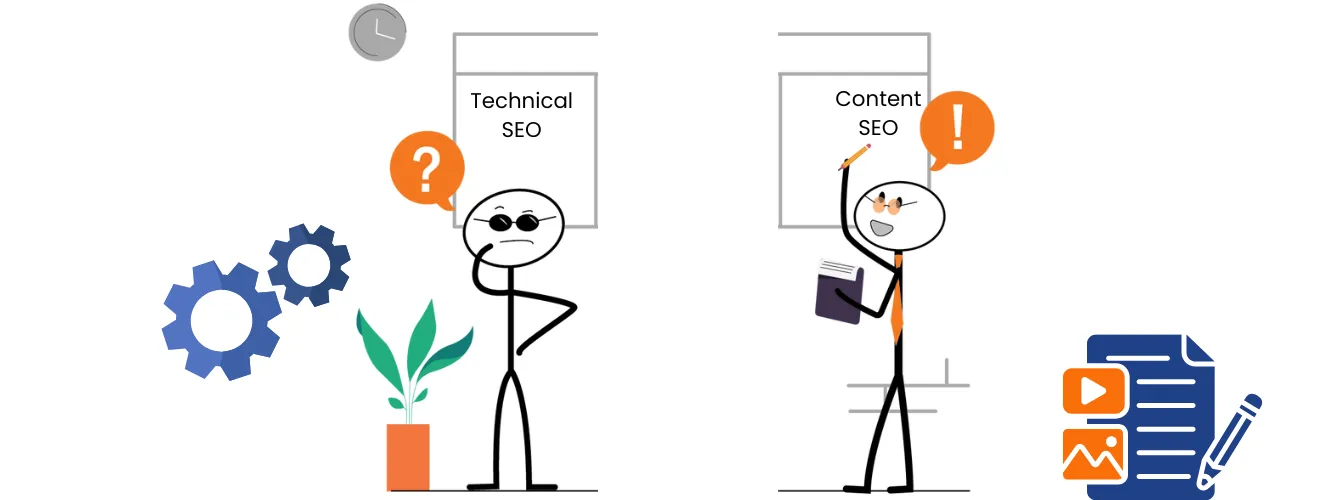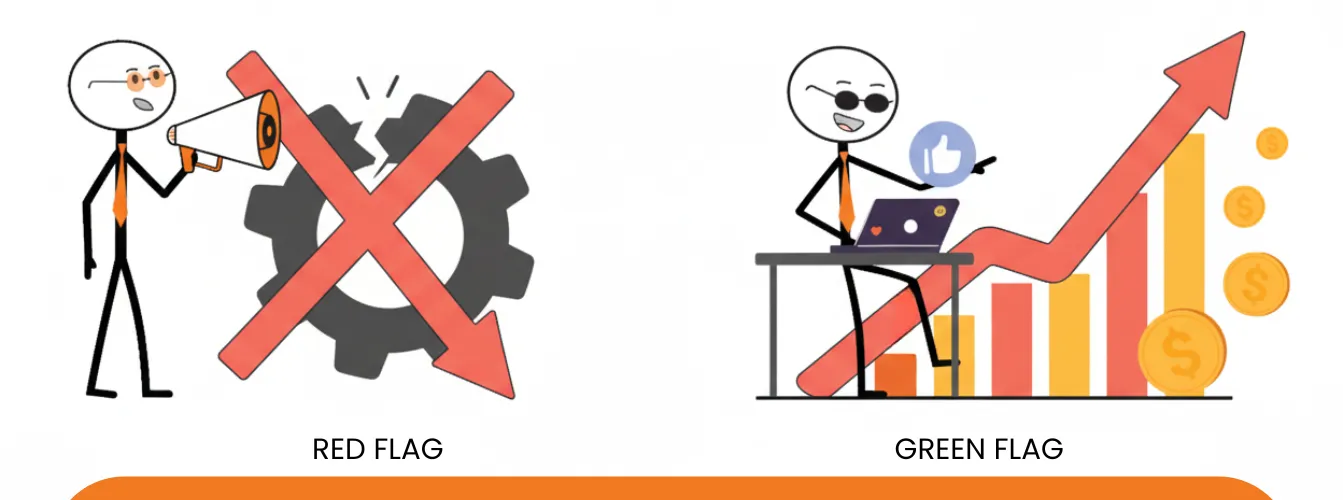Unlinked brand mentions are among the easiest backlink wins in SEO—and many site owners don’t realize they’re missing out. If your brand gets covered in blogs, media, or reviews without an actual link, you’re losing SEO value and visibility. In 2025, mastering unlinked mentions is fundamental for any authority-building strategy.
In this guide, you’ll learn:
- How to find unlinked brand mentions with Ahrefs, Moz, and Google Alerts
- How to prioritize and manually verify those mentions
- Outreach methods that turn mentions into backlinks
- How to automate the process for scale and success
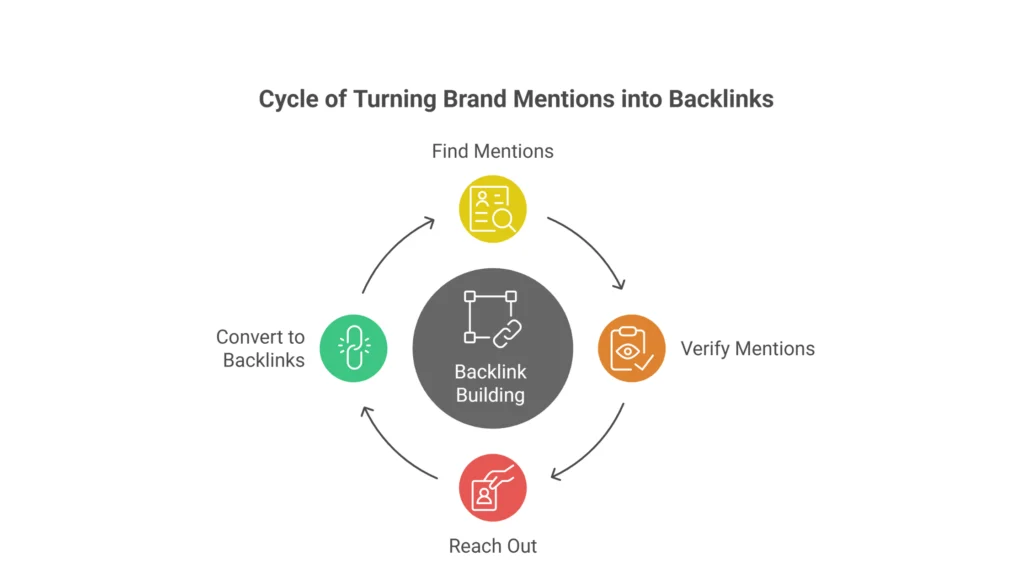
Let’s turn every passive mention into active, high-quality SEO results.
Why is Reclaiming Unlinked Brand Mentions Crucial for SEO and Backlink Building?
Backlinks from relevant, reputable sources remain a core Google ranking factor—they signal trust, authority, and popularity. When your brand is already mentioned but not linked, you’re halfway to gaining a valuable backlink with minimal effort.

Benefits of reclaiming unlinked mentions:
- Effortless, contextually relevant backlink opportunities
- Enhanced website authority and credibility
- Improved off-page SEO (higher positions for target keywords)
- More brand visibility and recognition in your industry
- Greater relationship-building opportunities with publishers
Search engines treat backlinks as trust signals—so take advantage of every unlinked mention as a chance to strengthen your site’s authority.
How to Find Unlinked Mentions (Step-by-Step)?
Locating and converting unlinked mentions involves a mix of automation and human review. Here’s how to find unlinked brand mentions effectively:
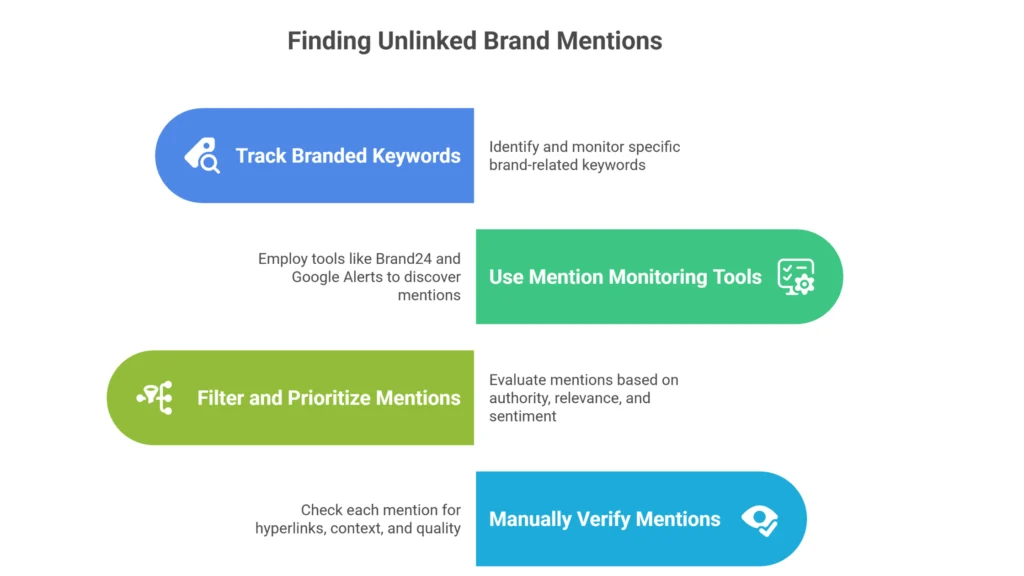
Step 1: Track Your Branded Keywords
The first step is setting up consistent tracking for all relevant branded terms, including:
- Your brand name and variations
- Main product or service names
- Founders, executives, or any signature industry terminology associated with you
This approach helps you net the broadest range of unlinked mentions—essential for modern semantic SEO.
Step 2: Use Mention Monitoring Tools
Using Ahrefs to Find Unlinked Mentions
Ahrefs Content Explorer is a powerful tool for this task:
- Enter your brand name (and variations) in Content Explorer.
- Filter results by “One page per domain” to avoid duplicates.
- Export the list and compare against your backlink profile to find pages that mention your brand but don’t link.
Ahrefs’ Unlinked Mentions feature streamlines this process. It quickly shows websites that reference your brand but haven’t yet linked to you, making it easy to prioritize outreach.
Using Moz to Find Unlinked Mentions
Moz’s Fresh Web Explorer or “Unlinked Mentions Tool” makes it simple to:
- Set up alerts for your brand keywords
- Discover new webpages naming your brand without linking
- Filter by domain authority or sentiment for quality targeting
Additional Tools:
- Brand24 – Real-time alerts, filtering by domain authority or traffic
- Google Alerts – Free tool for brand or keyword tracking
- SEMrush Brand Monitoring – For comprehensive coverage and further link-building insights
Using these platforms together gives you the most complete view across different search indexes and language variations.
Step 3: Filter and Prioritize Mentions
Not all mentions are created equal. Prioritize those that appear on:
- High-authority or high-traffic domains
- Articles or reviews relevant to your niche
- Positive, favorable content (context matters for link equity!)
Refine your list using metrics like Domain Rating (DR), Domain Authority (DA), page traffic, and content relevance.
Step 4: Manually Verify Mentions

Manual review is still essential. Use CTRL+F on each URL to find:
- If your brand is already hyperlinked or truly unlinked
- The relevance and context of the mention (does the source or topic align with your brand?)
- The overall page quality—linking from low-value directories or spammy sites is not beneficial
Make sure to only pursue contextual, high-value unlinked brand mentions for outreach.
How to Turn Mentions into Backlinks?
Transforming an unlinked mention into a backlink involves smart, respectful communication and offering genuine value.
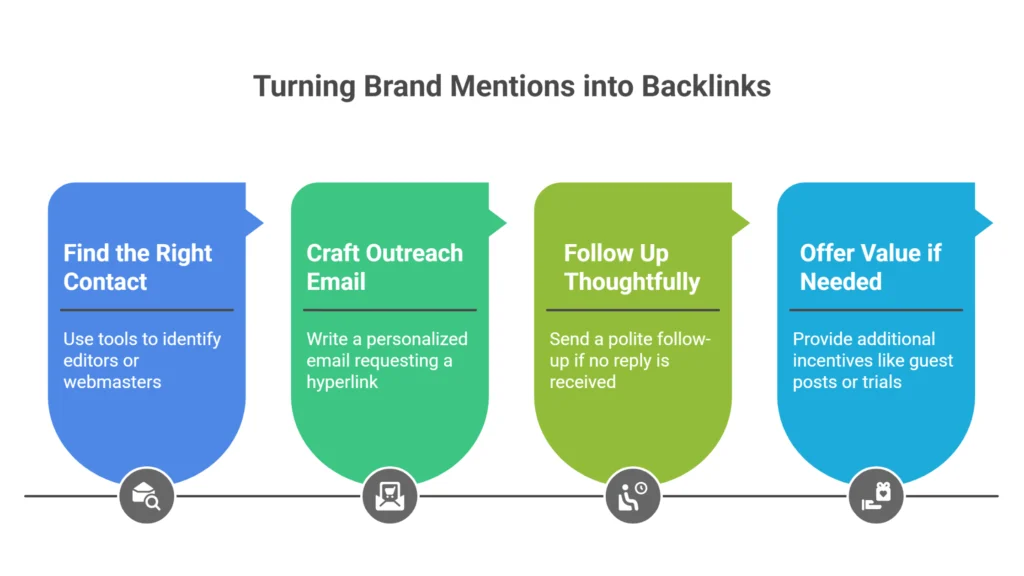
Step 1: Find the Right Contact
Locate the decision-maker for content updates:
- Hunter.io – Great for finding the correct email address.
- LinkedIn – Search for editors, authors, or webmasters.
- Website “About,” “Contact,” or “Team” pages often list responsible parties.
Step 2: Craft a Short, Personalized Outreach Email
Keep your message succinct, friendly, and value-driven:
- Address them by name
- Reference the exact page and your brand’s mention
- Gently request a link to the most relevant page on your site
- Offer reciprocal value (guest post, share, etc.)
Sample template:
“Hi [Name],
I noticed you mentioned [Brand] in your recent article [Title]. Would you mind adding a quick link to our official homepage? It helps your readers find us, and we’d be happy to share your post as well. Thank you for the shoutout!“
Step 3: Follow Up Thoughtfully
If no response after 4–7 days:
- Send a polite reminder referencing your original email.
- Restate the value/benefit their audience receives from the link.
- Offer help if there are technical hurdles.
Step 4: Offer Value if Needed
To increase your success rate:
- Offer a guest post
- Provide a free product trial
- Share their article on your social media
- Deliver a custom infographic or data set
building trust, offering value, and staying responsive to improve your chances of a positive outcome.
🤝 Offer Value in Return
If someone is hesitant to link back, or if you’re reaching out to high-authority websites, offer a value exchange to make it worth their time.
💡 Value You Can Offer:
- Guest Post Contribution: “I’d love to contribute a high-quality guest post for your blog!”
- Free Product Trial: “We can grant you and your team access to [tool/service] for review.”
- Social Media Promotion: “We’ll gladly promote your article through our social channels.”
- Exclusive Data/Infographic: “We can create visual assets or supply fresh research to enhance your post.”
- These extras often tip the balance for competitive or high-profile publishers.
Takeaways: How to Turn Mentions into Backlinks
- Always offer real value when needed (content, promo, insights)
- Use Brand24, Ahrefs, Moz, and Google Alerts to find unlinked mentions at scale
- Manually check for quality and true “unlinked” status
- Find the right contact (Hunter.io, LinkedIn)
- Reach out with brief, personalized, and friendly messages
- Don’t forget to follow up—4-7 days is ideal
- Track results and refine your process regularly!
Automation Tools to Speed Up the Process
| Category | Tool | Description |
|---|---|---|
| Monitoring | Brand24 | Real-time alerts with filters |
| Google Alerts | Free, basic email alerts | |
| SEO Metrics | Ahrefs | DR, traffic, backlink profile |
| SEMrush | Brand and link monitoring | |
| Email Discovery | Hunter.io | Email lookup and verification |
| Snov.io | CRM + automated outreach | |
| Outreach | BuzzStream | Email sequencing + relationship tracking |
| Mailshake | Prebuilt templates + follow-up automation |
💡 Pro Tip:
Automate monitoring and the first email contact—but always personalize your follow-ups. Human connection seriously boosts response and link rates.
Frequently Asked Questions
What is an unlinked brand mention?
A reference to your brand on another site—with no hyperlink. These “passive citations” can become powerful backlinks.
Why care about unlinked mentions?
They’re easy link wins. The publisher already thinks you’re valuable—half the work is done!
How do I find unlinked brand mentions using Ahrefs or Moz?
In Ahrefs, use Content Explorer or the Unlinked Mentions tool.
In Moz, use Fresh Web Explorer or set up “unlinked mentions” alerts.
Always pair with a backlink audit to verify there’s no existing link.
Who do I contact for link requests?
Target the author, editor, or a content manager. Use Hunter.io or LinkedIn for accuracy.
What to say in the outreach?
Be direct, polite, and grateful. Reference their article, thank them, and kindly ask for a link.
What if I don’t get a reply?
Follow up after 4–7 days, stay professional, and consider offering bonus value for their time.
Can I automate this process?
You can mostly automate monitoring and first touch. For best link conversion, personally handle follow-ups and value offers.
Final Thoughts: Reclaiming Brand Mentions to Build Authoritative Backlinks
In 2025, turning unlinked brand mentions into quality backlinks is one of the best ROI strategies in SEO—especially for brands that want to compound their authority and outrank competitors. With smart tools (Ahrefs, Moz Explorer, Brand24), careful manual review, and thoughtful, value-based outreach, any brand can capitalize on links they’ve already earned in the eyes of their industry.
Key actions:
- Automate monitoring
- Validate each opportunity
- Personalize outreach and negotiate value
- Build lasting relationships—don’t just chase links
Want even better results at scale? The right digital marketing agency in Lahore can refine and automate this process for you, bringing consistent high-impact backlinks and trusted authority to your brand—so you win at SEO in 2025 and beyond.



